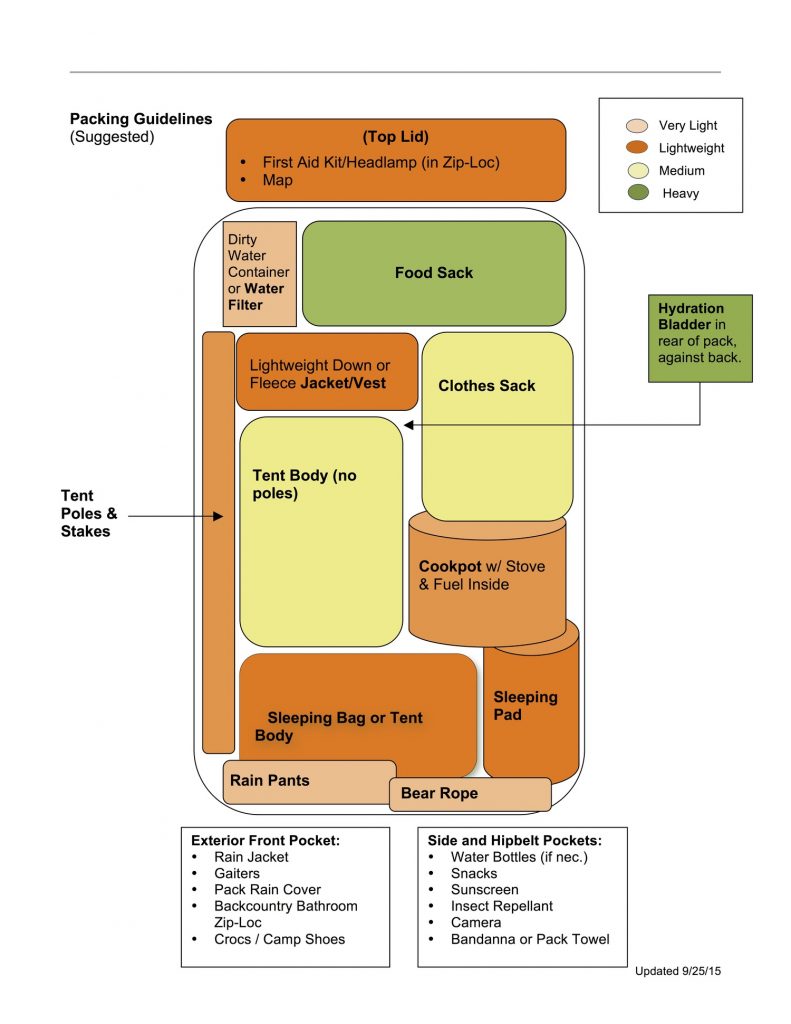In NYC, we were lucky to have a perfect, clear night for our outdoor Mappy Hour at Hostelling International New York. Along with BBQ, Agua Energy Water, and Brooklyn Lager, we got to meet new adventure buddies, hear stories from in ternational travelers, and learn a bit about backpacking from the Appalachian Mountain Club. Debbie M. of the AMC’s backpacking committee spoke on best practices for backpacking – below are notes from her handy handout!
ternational travelers, and learn a bit about backpacking from the Appalachian Mountain Club. Debbie M. of the AMC’s backpacking committee spoke on best practices for backpacking – below are notes from her handy handout!
3-SEASON BACKPACKING GUIDELINES
Try to keep your pack as light as possible – aim for a total weight of 25 lbs. (or less!) with food and water for a 2 – 3 day weekend.
Ø Your 4 main items should weigh no more than 10 lbs. combined (backpack, tent (w/optional footprint), sleeping bag and sleeping pad. Make a list and weigh every item. Try to stay in the following weight ranges:
o Pack: 2 – 4 lbs.
o Tent/Hammock: 2 – 3 lbs. for solo tents or 4 – 5 lbs. for 2-person tents shared between 2 people.
o Sleeping Bag: 2 lbs. for a 25 – 35 degree bag
o Sleeping Pad: 1 lb.
Ø Separate items into a few categories (clothes, first aid/safety, toiletries/hygiene, cook kit, food, etc.) so they are easy to find. Use Zip-loc bags and compression/stuff sacks to sort, organize and reduce packing size.
Ø Use small, travel-sized items & containers. Put small items inside larger items (stove inside cook pot, etc.)
Ø Place items that are both light and bulky at the bottom of the pack: Sleeping bag/pad, rain pants, rope, etc.
Ø Put mid-weight items (clothes, tent – without poles, cook kit, etc.) above the bottom layer.
Ø Put heavier items (food, water reservoir, etc.) in the upper middle or top layer, close to your back, so your hips bear the weight.
Ø Put light, quick-need items like safety/first aid kit, toilet paper/trowel, etc. in top lid or front pocket.
Ø Use the Side and/or Hip Belt Pockets of pack for snacks, camera, bandana, sunscreen, insect repellant, etc.
Ø Have your rain jacket/pack cover handy – in the front pocket of your pack so you don’t have to open the pack if it starts to rain.
Ø Keep the pack weight balanced so one side is not heavier than the other.
Ø Minimize the number of items strapped to the outside of your pack to avoid snagging on branches or tearing on rocks.
Clothing/SHOES:
(Bring clean clothes & shoes to leave in the car to wear after the hike.)
Ø Hiking Shoes/Boots, Hiking Clothes, Socks, and Hat
Ø Camp Clothes/Base Layers, Lightweight Down or Fleece Jacket, Warm Hat, Camp Shoes
Ø Rain Jacket (or Poncho), Rain Pants, Gaiters
PACK ITEMS: Backpack, Rain Cover, Waterproof Stuff Sacks, Garbage Bag and Zip Loc bags.
SLEEPING GEAR/SHELTER: Sleeping Bag, Sleeping Pad & Tent/Hammock/Tarp (pack poles/stakes separately)
SAFETY GEAR: First Aid Kit, Headlamp, Small Pocket Knife or Multi Tool; Duct Tape, Insect Repellant, Sunglasses & Sunscreen, Plastic Whistle, Compass, Hiking Map
PERSONAL ITEMS: (pack Bathroom Kit items and small trowel in a separate quart-size Zip-Loc bag)
Bandanna/Camp Towel, Toothbrush/Toothpaste, Hygiene Items, Ear Plugs, Bathroom Kit & Digging Tool/Trowel
KITCHEN/COOKING GEAR:
Ø Cook Pot w/Lid, Cup/Mug, Spork, Stove, Fuel, Windscreen, Matches/Lighter.
Ø Water Purification and Water Bottles or Hydration Reservoir
Ø Food (repackage food in Zip-Loc bags to reduce bulk and weight)
Eat foods that supply good healthy energy and higher calories that won’t burn off too quickly. Raw, dehydrated or freeze-dried foods don’t have a high liquid content, and are lighter to carry.

EXTRAS: Hiking Poles, Seat Pad, Camera, Book/Magazine, etc. One indulgent item won’t break your back!
MORE RESOURCES:
Join us at October Mappy Hour at the Victorinox Swiss Army store in Soho
Check out the Appalachian Mountain Club‘s upcoming trips.
Sign up for the HI New York Meetup group to hear more about their community events.

